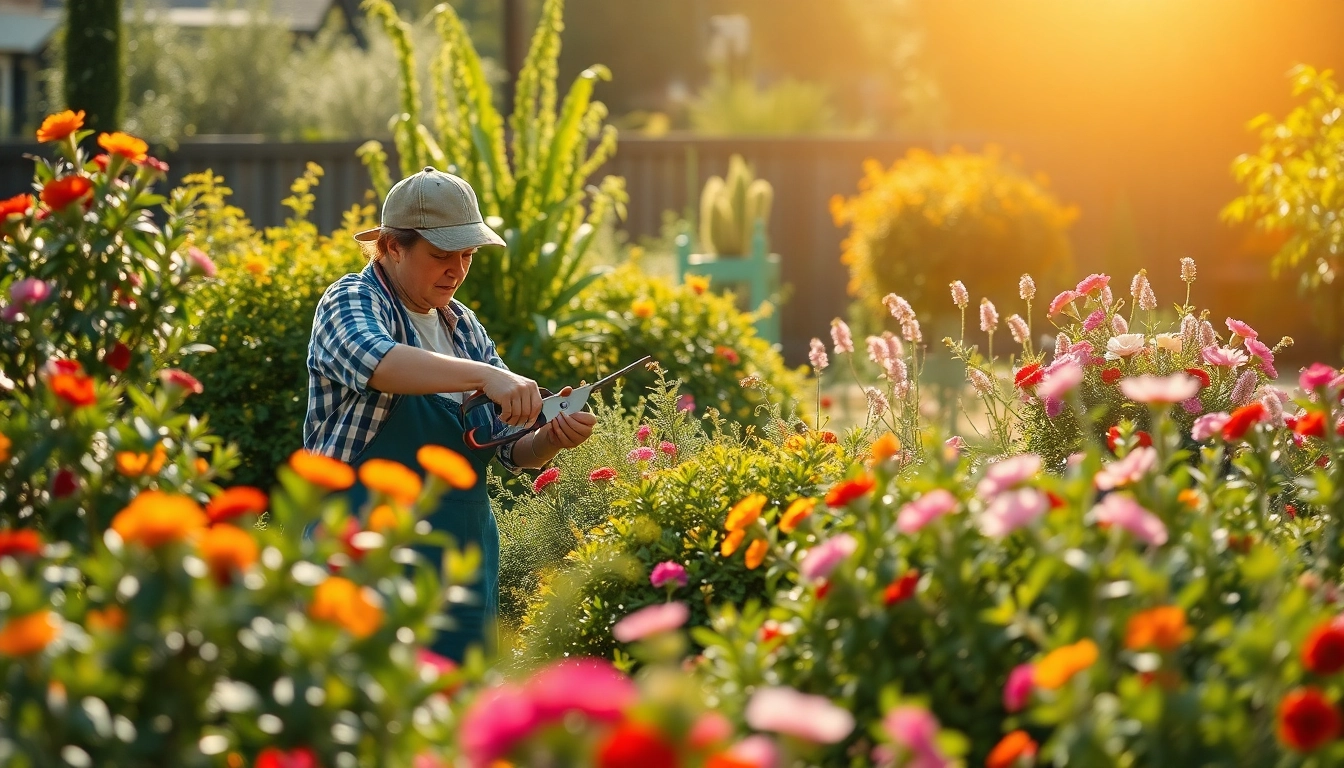Understanding Garden Maintenance Services
What Is a Garden Maintenance Service?
A garden maintenance service encompasses a range of professional services designed to keep gardens healthy, beautiful, and thriving. These services can be offered by individual landscapers or companies specializing in horticulture and landscape maintenance. The main goal is to provide support in maintaining outdoor spaces, enhancing their aesthetic appeal, and promoting plant health throughout the seasons. Whether it’s a small residential garden or expansive commercial property, garden maintenance services can be tailored to meet specific needs.
Importance of Regular Maintenance
The beauty of any garden is the result of ongoing care and attention. Regular maintenance is crucial for several reasons, including:
- Enhancing Aesthetic Appeal: Regular maintenance ensures that your garden remains vibrant, with healthy plants that bloom beautifully.
- Promoting Plant Health: Consistent care, including watering, fertilizing, and pest management, keeps plants healthy and capable of thriving.
- Preventing Major Problems: Proactive maintenance helps identify and address issues before they develop into significant problems, like pest infestations or plant diseases.
- Boosting Property Value: A well-maintained garden contributes to the overall appeal of your property, potentially increasing its market value.
Key Services Included in Packages
Garden maintenance services typically include a comprehensive suite of offerings which may vary between providers. Common services encompass:
- Lawn Care: Mowing, aerating, and fertilizing lawns to keep them lush and green.
- Weeding: Regularly removing weeds that can choke the life out of your plants.
- Pruning: Trimming back plants and trees to encourage healthy growth and flowering.
- Pest Control: Monitoring and treating gardens for pests and diseases through chemical or organic methods.
- Seasonal Clean-Up: Preparing the garden for changing seasons by cleaning up debris and preparing soil for planting.
Choosing the Right Garden Maintenance Service
Factors to Consider When Hiring
Selecting the right garden maintenance service can be a daunting task, especially given the many options available. Here are some vital factors to consider:
- Experience: Look for companies with a proven track record of providing quality services. Experience often correlates with better service quality.
- Services Offered: Ensure that the service provider offers a comprehensive range of maintenance services tailored to your garden’s specific needs.
- Certifications: Professional certifications or affiliations with horticultural organizations can indicate credibility and expertise.
- Insurance: Check that the company has liability insurance to protect against potential damage or accidents while working on your property.
How to Evaluate Service Providers
Once you’ve narrowed down your options, it’s time to evaluate potential service providers through the following steps:
- Request Quotes: Obtaining quotes from multiple providers can give you a better understanding of market pricing and services offered.
- Assess Communication: Gauge how responsive and clear the communication is; this is crucial for a successful working relationship.
- Check Availability: Inquire about the service provider’s availability, especially during peak gardening seasons when demand might be high.
- Review Contracts: Before signing any agreements, ensure you fully understand the terms of service, including cancellation policies and service guarantees.
Reading Reviews and Testimonials
Online reviews and testimonials can provide valuable insights into the quality of a garden maintenance service. Look for feedback on platforms such as Google Reviews, Yelp, and social media. Pay attention to comments about punctuality, quality of work, and customer service. Moreover, consider asking for references directly from the service provider, allowing you to hear from previous clients about their experiences.
Common Challenges in Garden Maintenance
Seasonal Variations and Their Impact
Gardens face different challenges throughout the seasons. Understanding these variations is key to successful garden maintenance. For example:
- Spring: This season requires addressing weeds, pests emerging from dormancy, and preparing the soil for planting.
- Summer: The focus shifts to efficient watering practices and managing heat stress in plants.
- Fall: Preparation for winter includes cleaning up dead plants and mulching essential to protect the soil.
- Winter: In colder climates, the focus is on protecting plants from frost damage and planning for the upcoming spring.
Pest and Disease Management
Pest and disease management is a significant aspect of garden maintenance. Proper identification and treatment of issues can save plants from irreversible damage. Integrated Pest Management (IPM) techniques are often employed, which include:
- Monitoring: Regularly inspecting plants for signs of pests or disease.
- Cultural Controls: Implementing practices such as crop rotation, selecting disease-resistant plant varieties, and proper sanitation.
- Biological Controls: Introducing beneficial insects or natural predators to control pest populations.
- Chemical Controls: As a last resort, applying pesticides responsibly and following all recommended guidelines and regulations.
Maintaining Soil Health and Fertility
The health of garden soil is fundamental to plant growth. Regular maintenance practices should focus on:
- Testing Soil: Conducting soil tests to understand nutrient levels and pH balance.
- Amending Soil: Adding organic matter like compost or well-rotted manure to improve soil structure and nutrient content.
- Mulching: Applying mulch to retain moisture, suppress weeds, and contribute to soil fertility as it decomposes.
- Avoiding Compaction: Limiting heavy foot traffic on garden beds to prevent soil compaction, which hinders root growth.
Best Practices for Effective Garden Care
Tools and Equipment You Should Use
Utilizing the right tools is essential for efficient garden maintenance. Here’s a list of essential tools for any gardener:
- Hand Tools: Such as trowels, pruners, and weeding forks for detailed work.
- Power Tools: Including lawn mowers, hedge trimmers, and leaf blowers, which can significantly reduce manual labor.
- Safety Gear: Gloves, goggles, and sturdy boots to protect during maintenance tasks.
- Watering Equipment: Hoses, watering cans, and irrigation systems to ensure plants receive adequate hydration.
Watering Techniques for a Healthy Garden
Proper watering techniques are pivotal to plant health. Here are some effective strategies:
- Deep Watering: Watering deeply and less frequently encourages deep root growth and resilience.
- Timing: Watering early in the morning or late in the evening minimizes evaporation and offers optimal hydration for plants.
- Using Mulch: Applying organic mulch helps retain soil moisture, reducing the frequency of watering.
- Implementing Irrigation Systems: Using drip irrigation minimizes water waste and provides consistent moisture directly to plant roots.
Pruning Strategies for Different Plant Types
Pruning is a critical component of garden maintenance that enhances plant health and flowering. Different plants require various pruning strategies:
- Deciduous Trees: Best pruned in late winter or early spring before new growth begins.
- Evergreens: Can be lightly pruned in early spring or late summer to maintain shape without disrupting growth.
- Flowering Shrubs: Prune spring-blooming varieties right after flowering, while summer-blooming types should be pruned in early spring.
- Perennials: Cut back dead foliage in the fall to promote new growth in spring.
Measuring Success: Performance Metrics for Garden Maintenance
Visual Indicators of a Healthy Garden
One of the simplest ways to gauge the success of your garden maintenance efforts is through visual inspection. Healthy plants exhibit:
- Vibrant Colors: Leaves should be lush and green, while flowers should show bright, rich colors.
- Robust Growth: Plants should display steady growth, indicating that they’re receiving adequate nutrients and care.
- Minimal Pests: A healthy garden will have few pest infestations, with natural predators in balance.
Setting Goals and Achieving Them
Setting specific, measurable goals for your garden can help track progress and success. Consider the following approaches:
- Establish Baseline Measurements: Begin by recording current metrics such as the number of healthy plants, flower blooms, and pest counts.
- Set Seasonal Goals: Formulate objectives for each season, such as increasing flower blooms by a certain percentage or reducing pest populations.
- Document Changes: Keep a garden journal to document plant performance and intervention results, which can inform future decisions.
Customer Satisfaction and Engagement
For professional garden maintenance services, customer satisfaction is a critical performance metric. Engagement can be measured through:
- Surveys: Sending surveys to clients after services to gather feedback on their satisfaction and areas for improvement.
- Repeat Business: Tracking the percentage of clients who return for additional services can indicate satisfaction.
- Social Media Interaction: Engaging with customers on social media platforms can enhance relationships and transparently address concerns.








